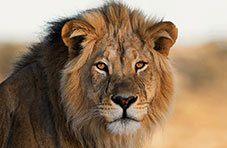Last time we’ve introduced the Big Five, a group of animals which have made it to the list due to the danger and difficulty involved when hunting them on foot. The term was coined by hunters in late 19th century but is still used today, only in different context. African lion, African elephant, Cape buffalo, African leopard and rhinoceros are nowadays referred to as the Big Five by tourist industry when describing the attractions of wildlife safaris. To learn more about these five beautiful animals, over the next period we’ll share with you some more and less known facts.
Lion – The Social Cat
Lions are powerful and beautiful animals, and the only cats which live in groups. These social creatures function in prides which usually include up to three males, a dozen females and their offspring. A large dominant male wins his leading position in a fierce competition with the other guys in the group. All of the lionesses are related and they are the pride's primary hunters. Exercising teamwork, the girls prey together on antelopes, zebras and other large animals of the open plains.
Male lions are easily recognised by their manes, a full set of hair encircling their heads. It’s an important feature when it comes to attracting the ladies, as lionesses favour males with the densest and darkest manes. This second-largest cat after the tiger can weigh in access of 250 kg. Male lions are in their prime from five to nine years of age and rarely live to be old. This is due to injuries they suffer during frequent fights with the rival males. Females are smaller and more agile than their mates. They both have tails ending in a hairy tuft, function of which we do not know. Cubs are born with brown spots on their body, resembling a leopard, which fade as they reach adulthood.
Lioness: A Mother and a Hunter
Females give birth to one to four cubs and subsequently hunt by themselves close to the den where the cubs are kept. When they are born, cubs are blind and pretty much helpless. Weighing 1-2 kg at birth, they will begin crawling a day or two later and walking when they’re about three weeks old. Lioness carries them around by the nape of the neck. When the cubs are six to eight weeks of age, their mother will rejoin the pride. Lionesses will often synchronise their reproductive cycles and cooperate in raising and suckling of their young.
Normally inhabiting savannahs and open plains, these admirable animals mark their area with urine, warn intruders by menacing roars and chase off animals which dare to enter their turf. They spend a lot of their time resting, about 20 hours daily. Lions will often scavenge animals which were killed by other predators or have died from natural causes, and most of the active hunting will be done by lionesses.
They will sneak up to the victim and strangulate or asphyxiate it. Smaller prey will be eaten where it was killed, but bigger kills are often dragged to pride area. Male lion can eat up to 30 kg, after which he’ll need to rest for a few hours before continuing to feed. Hunting in groups, lions are capable of taking down most animals, though they will normally not attack adult elephants, adult hippopotamuses, rhinoceroses and gazelles.
Meow, Roar, Grunt, Purr… What Did You Say?
Lions seem to be communicating through various tactile gestures, such as head rubbing and licking, which appear to be a form of greeting. They also exhibit an array of facial expressions, body postures and a variety of vocals. They will meow, roar, grunt, moan, growl, snarl, purr, hum, puff and woof, each sound conveying a different message. Their roar can be heard from up to 8km away, telling other lions where they are, showing how big they are and warning those from the other prides to keep away. When they feel threatened, lions will show their sharp teeth and claws and try to make themselves look as big as possible. When he wants to tell his pride colleague he’s out of line, lion will give him a gentle smack on the head or a light bite to the neck. When playing together, these large cats hum and puff to express their happiness.
Can We Reverse The Tragic Pattern?
About 10,000 years ago, lion was the most widespread large land-walking animal after humans. They were roaming most of Africa and parts of Asia and Europe but today they can be seen only in parts of sub-Saharan Africa, with a small population of Asian lions living in India's Gir Forest National Park. Starting with about half a million at the beginning of 20th century, there are only 25,000 to 30,000 lions to be found in Africa today. We’re not completely sure why their numbers have so significantly declined, though it surely has something to do with loss of habitat and us humans. Although hyenas, leopards and wild dogs will kill lion cubs, lions have no natural enemies other than people. Looking at this magnificent creature, doesn’t that make you feel sad?




